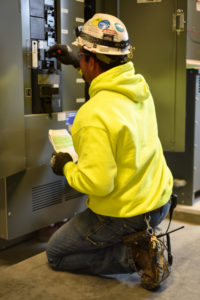04.04.2023
Does That Job Have a Permit?
 In the electrical industry, there are times when working on energized equipment is warranted or justified. However, I would argue that energized work – hot work – is less likely to be needed today if you know how to accurately apply the standards and requirements of the latest edition of NFPA 70E and OSHA, CFR 1910.333(a)(1).
In the electrical industry, there are times when working on energized equipment is warranted or justified. However, I would argue that energized work – hot work – is less likely to be needed today if you know how to accurately apply the standards and requirements of the latest edition of NFPA 70E and OSHA, CFR 1910.333(a)(1).
In section 110.4 of the 2021 edition of 70E, you can find the conditions when energized work within the restricted approach boundary of electrical equipment is allowed. First, when the work is infeasible to work on if deenergized, which would include testing, IR scans and troubleshooting, or working on systems operating at less than 50 volts. Lastly, if it can be proven that additional risks and hazards will be introduced while the equipment is disconnected; an example would be shutting off the fan motor to a special hazardous environment which could result in the build up of deadly fumes in an area. Even work within the critical branch of a health care facility or hospital can be scheduled as a planned outage; OSHA does not consider loss of revenue as justification for energized work.
Any of these scenarios would require an Energized Electrical Work Permit (EEWP). The EEWP is not a green flag for energized work but rather an important document that, when filled out properly, will cause the workers and all stakeholders to consider if the work must be done energized and if it can be completed in a reasonable, practical and safe manner. Section 120.5 of 70E outlines the eight steps that must be completed before we consider the equipment as electrically safe.
Some of the elements of the EEWP can be located in 130.2(B) and should include the following:
- Description of the circuit and equipment and location.
- Description of the work to be performed.
- Justification of why the power cannot be shut down.
- Description of the safe work practices deployed.
- Results of a shock risk assessment. (130.4(A).
- Voltage
- Limit approach boundary.
- Restricted approach boundary.
- PPE required.
- Results of the arc flash risk assessment (130.5).
- Incident energy and working distance or arc flash PPE category.
- PPE and other protective equipment required.
- Arc flash boundary.
- Means to keep unqualified persons out of the work area.
- Evidence of completion of a job briefing, including any specific hazards of this task.
- Energized work approval from all stakeholders, including SIGNATURES!
When people are required to sign off on an energized task, often their minds are changed and other options considered for the work to be done in an electrically safe manner. Clients can either plan on an outage with a known timeframe and cost before the work, or they can risk an unplanned outage with an indefinite time frame and countless unknown costs. In the case of an arc flash incident, equipment may not be repairable after the event. If the equipment is obsolete, the cost and duration of the outage increases. This information should be included in the EEWP to accurately communicate the potential extent of damage.
In my training work at FTI, I share this mantra with our team members: “If plumbers must turn off water systems to work, why don’t we?” What is the worst outcome if the building is flooded with water? Contrast that to electrical systems, which can have far more disastrous outcomes.
When planning electrical work, we can and do find ways to work safer and put systems into electrically safe working conditions (ESWC). In my experience in training Arc Flash classes, I can often see apprentices being more acceptable to these standards than the more experienced generation. Energized work should be the last resort for organizations, and you must request that all the boxes be checked before the task is started and that the work can be done safely. If not, don’t sign off. Stand down. Your friends and family will thank you.
When troubleshooting and testing, the EEWP is not required. However, the proper PPE is required while doing the task. Verify the testing and troubleshooting measurements, establish an electrically safe working condition then remove the PPE required for the incident energy at that part of the system.
If your company is seeking compliance with the requirements of OSHA, NFPA 70E, reach out to FTI for information on classes, customized training or guidance in implementing an electrical safety program and policies from certified professionals – for the protection of your clients as well as you and your employees. Implementing safe electrical policies not only protects your employees, but it also protects you from being up the creek without a permit.
If you enjoyed this blog article, please subscribe to stay up to date on the latest industry news from our experts at Faith Technologies.



